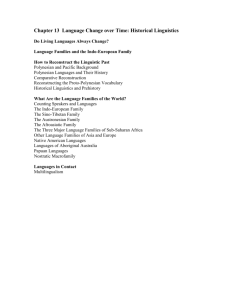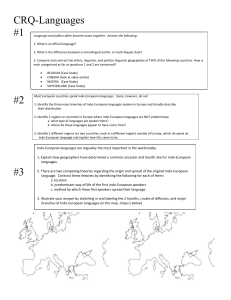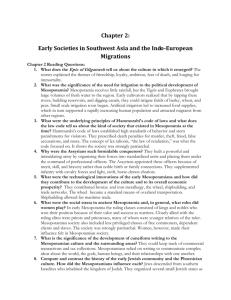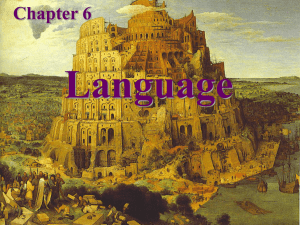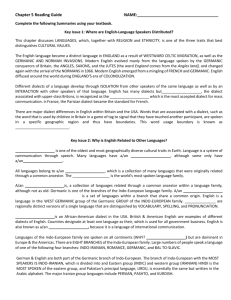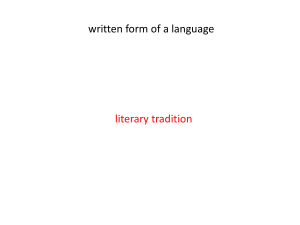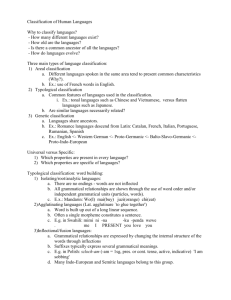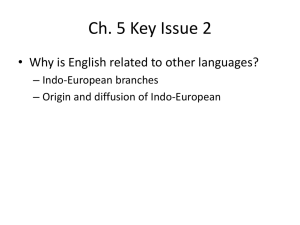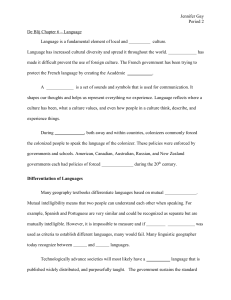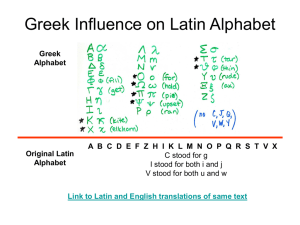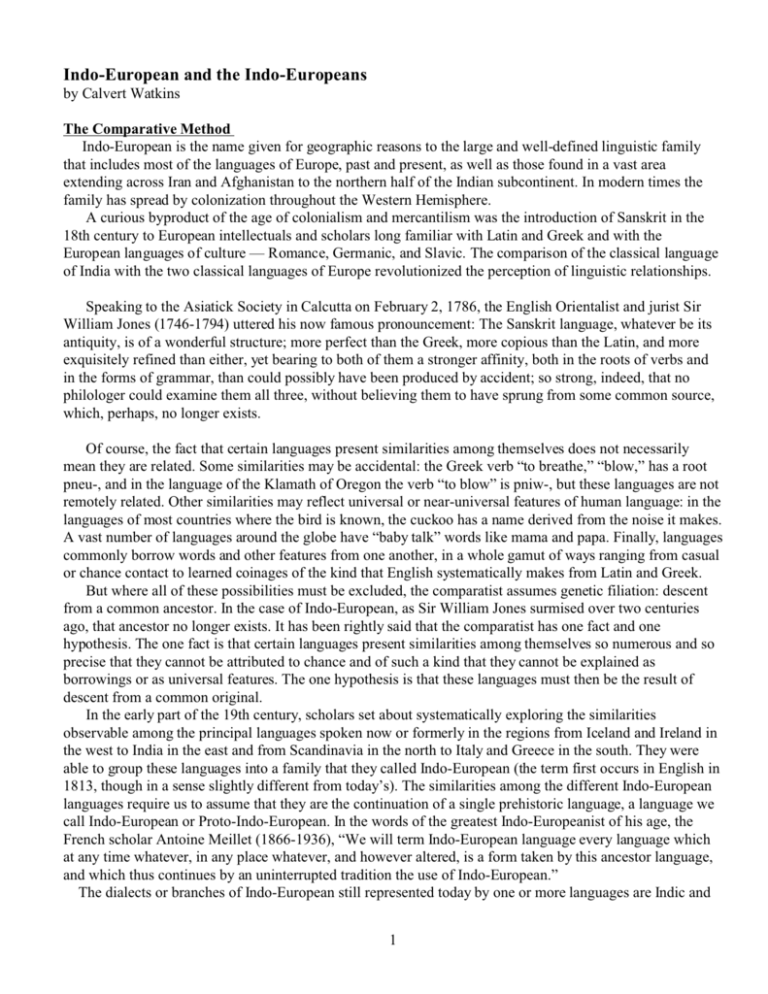
Indo-European and the Indo-Europeans
by Calvert Watkins
The Comparative Method
Indo-European is the name given for geographic reasons to the large and well-defined linguistic family
that includes most of the languages of Europe, past and present, as well as those found in a vast area
extending across Iran and Afghanistan to the northern half of the Indian subcontinent. In modern times the
family has spread by colonization throughout the Western Hemisphere.
A curious byproduct of the age of colonialism and mercantilism was the introduction of Sanskrit in the
18th century to European intellectuals and scholars long familiar with Latin and Greek and with the
European languages of culture — Romance, Germanic, and Slavic. The comparison of the classical language
of India with the two classical languages of Europe revolutionized the perception of linguistic relationships.
Speaking to the Asiatick Society in Calcutta on February 2, 1786, the English Orientalist and jurist Sir
William Jones (1746-1794) uttered his now famous pronouncement: The Sanskrit language, whatever be its
antiquity, is of a wonderful structure; more perfect than the Greek, more copious than the Latin, and more
exquisitely refined than either, yet bearing to both of them a stronger affinity, both in the roots of verbs and
in the forms of grammar, than could possibly have been produced by accident; so strong, indeed, that no
philologer could examine them all three, without believing them to have sprung from some common source,
which, perhaps, no longer exists.
Of course, the fact that certain languages present similarities among themselves does not necessarily
mean they are related. Some similarities may be accidental: the Greek verb “to breathe,” “blow,” has a root
pneu-, and in the language of the Klamath of Oregon the verb “to blow” is pniw-, but these languages are not
remotely related. Other similarities may reflect universal or near-universal features of human language: in the
languages of most countries where the bird is known, the cuckoo has a name derived from the noise it makes.
A vast number of languages around the globe have “baby talk” words like mama and papa. Finally, languages
commonly borrow words and other features from one another, in a whole gamut of ways ranging from casual
or chance contact to learned coinages of the kind that English systematically makes from Latin and Greek.
But where all of these possibilities must be excluded, the comparatist assumes genetic filiation: descent
from a common ancestor. In the case of Indo-European, as Sir William Jones surmised over two centuries
ago, that ancestor no longer exists. It has been rightly said that the comparatist has one fact and one
hypothesis. The one fact is that certain languages present similarities among themselves so numerous and so
precise that they cannot be attributed to chance and of such a kind that they cannot be explained as
borrowings or as universal features. The one hypothesis is that these languages must then be the result of
descent from a common original.
In the early part of the 19th century, scholars set about systematically exploring the similarities
observable among the principal languages spoken now or formerly in the regions from Iceland and Ireland in
the west to India in the east and from Scandinavia in the north to Italy and Greece in the south. They were
able to group these languages into a family that they called Indo-European (the term first occurs in English in
1813, though in a sense slightly different from today’s). The similarities among the different Indo-European
languages require us to assume that they are the continuation of a single prehistoric language, a language we
call Indo-European or Proto-Indo-European. In the words of the greatest Indo-Europeanist of his age, the
French scholar Antoine Meillet (1866-1936), “We will term Indo-European language every language which
at any time whatever, in any place whatever, and however altered, is a form taken by this ancestor language,
and which thus continues by an uninterrupted tradition the use of Indo-European.”
The dialects or branches of Indo-European still represented today by one or more languages are Indic and
1
Iranian, Greek, Armenian, Slavic, Baltic, Albanian, Celtic, Italic, and Germanic. The present century has seen
the addition of two branches to the family, both of which are extinct: Hittite and other Anatolian languages,
the earliest attested in the Indo-European family, spoken in what is now Turkey in the second and first
millennia B.C.; and the two Tocharian languages, the easternmost of Indo-European dialects, spoken in
Chinese Turkistan (modern Xinjiang Uygur) in the first millennium A.D.
English is the most prevalent member of the Indo-European family, the native language of nearly 350
million people and the most important second language in the world. It is one of many direct descendants of
Indo-European, one of whose dialects became prehistoric Common Germanic, which subdivided into dialects
of which one was West Germanic; this in turn broke up into further dialects, one of which emerged into
documentary attestation as Old English. From Old English we can follow the development of the language
directly, in texts, down to the present day.
This history is our linguistic heritage; our ancestors, in a real cultural sense, are our linguistic ancestors.
But it must be stressed that linguistic heritage, while it may tend to correspond with cultural continuity, does
not imply genetic or biological descent. Linguists use the phrase “genetically related” to refer simply to
languages descended from a common ancestor. The transmission of language by conquest, assimilation,
migration, or any other ethnic movement is a complex and enigmatic process that this discussion does not
propose to examine—beyond the general proposition that in the case of Indo-European no genetic
conclusions can or should be drawn.
Although English is a member of the Germanic branch of Indo-European and retains much of the basic
structure of its origin, it has an exceptionally mixed lexicon. During the 1400 years of its documented
history, it has borrowed extensively and systematically from its Germanic and Romance neighbors and from
Latin and Greek, as well as more sporadically from other languages (compare the Appendix of Semitic Roots
in English below, pages 2062-2068). At the same time, it has lost the great bulk of its original Old English
vocabulary. However, the inherited vocabulary, though now numerically a small proportion of the total,
remains the genuine core of the language; all of the 100 words shown to be the most frequent in the Corpus
of Present-Day American English, also known as the Brown Corpus, are native words; and of the second
100, 83 are native. A children’s tale like The Little Red Hen, for example, contains virtually no loanwords.
Yet precisely because of its propensity to borrow from ancient and modern Indo-European languages,
especially those mentioned above but including nearly every other member of the family, English has in a
way replaced much of the Indo-European lexicon it lost. Thus, while the distinction between native and
borrowed vocabulary remains fundamentally important, more than 50 percent of the basic roots of
Indo-European as represented in Julius Pokorny’s Indogermanisches Etymologisches Wörterbuch
[Indo-European Etymological Dictionary] (Bern, 1959) are represented in Modern English by one means or
the other. Indo-European therefore looms doubly large in the background of our language. ...
The comparative method—what we have called the comparatist’s “one fact and one
hypothesis”—remains today the most powerful device for elucidating linguistic history. When it is carried to
a successful conclusion, the comparative method leads not merely to the assumption of the previous
existence of an antecedent common language but to a reconstruction of all the salient features of that
language. In the best circumstances, as with Indo-European, we can reconstruct the sounds, forms, words,
even the structure of sentences—in short, both grammar and lexicon—of a language spoken before the
human race had invented the art of writing. It is worth reflecting on this accomplishment. A reconstructed
grammar and dictionary cannot claim any sort of completeness, to be sure, and the reconstruction may always
be changed because of new data or better analysis. But it remains true, as one distinguished scholar has put it,
that a reconstructed protolanguage is “a glorious artifact, one which is far more precious than anything an
archaeologist can ever hope to unearth.”
2
An Example of Reconstruction
Before proceeding with a survey of the lexicon and culture of the Indo-Europeans, it may be helpful to
give a concrete illustration of the method used to reconstruct the Proto-Indo-European vocabulary and a brief
description of some of the main features of the Proto-Indo-European language. The example will serve as an
introduction to the comparative method and indicate as well the high degree of precision that the techniques
of reconstruction permit.
A number of Indo-European languages show a similar word for the kinship term “daughter-in-law”:
Sanskrit snu, Old English snoru, Old Church Slavonic snkha (Russian snokhá), Latin nurus, Greek nuós, and
Armenian nu. All of these forms, called cognates, provide evidence for the phonetic shape of the prehistoric
Indo-European word for “daughter-in-law” that is their common ancestor. Sanskrit, Germanic, and Slavic
agree in showing an Indo-European word that began with sn-. We know that an Indo-European s was lost
before n in other words in Latin, Greek, and Armenian, so we can confidently assume that Latin nurus, Greek
nuós, and Armenian nu also go back to an Indo-European *sn-. (Compare Latin nix [stem niv-], “snow,” with
English SNOW, which preserves the s.) This principle is spoken of as the regularity of sound
correspondences; it is basic to the sciences of etymology and comparative linguistics.
Sanskrit, Latin, Greek, and Armenian agree in showing the first vowel as -u-. We know from other
examples that Slavic regularly corresponds to Sanskrit u and that in this position Germanic o (of Old English
snoru) has been changed from an earlier u. It is thus justifiable to reconstruct an Indo-European word
beginning *snu-.
For the consonant originally following *snu-, closer analysis is required. The key is furnished first by the
Sanskrit form, for we know there is a rule in Sanskrit that s always changes to (a sh-like sound) after the
vowel u. Therefore a Sanskrit snu- must go back to an earlier *snus-. In the same position, after u, an old -schanges to kh (like the ch in Scottish loch or German ach) in Slavic; hence the Slavic word, too, reflects
*snus-. In Latin always, and in Germanic under certain conditions, an old -s- between vowels changed to -r-.
For this reason Latin nurus and Old English snoru may go back to older *snus- (followed by a vowel) as
well. In Greek and Armenian, on the other hand, an old -s- between vowels disappeared entirely, as we know
from numerous instances. Greek nuós and Armenian nu (stem nuo-) thus regularly presuppose the same
earlier form, *snus- (followed by a vowel). All the comparative evidence agrees, then, on the Indo-European
root form *snus-.
For the ending, the final vowels of Sanskrit snu, Old English snoru, and Slavic snkha all presuppose
earlier - (*snus-), which is the ordinary feminine ending of these languages. On the other hand, Latin nurus,
Greek nuós, and Armenian nu (stem nuo-) all regularly presuppose the earlier ending *-os (*snus-os). We
have an apparent impasse; but the way out is given by the gender of the forms in Greek and Latin. They are
feminine, even though most nouns in Latin -us and Greek -os are masculine.
Feminine nouns in Latin -us and Greek -os, since they are an abnormal type, cannot have been created
afresh; they must have been inherited. This suggests that the original Indo-European form was *snusos, of
feminine gender. On the other hand, the commonplace freely formed ending for feminine nouns was *-. It is
reasonable to suggest that the three languages Sanskrit, Germanic, and Slavic replaced the peculiar feminine
ending *-os (because that ending was normally masculine) with the normal feminine ending *-, and thus that
the oldest form of the word was *snusos (feminine).
One point remains to be ascertained: the accent. Of those four language groups that reflect the
Indo-European accent—Sanskrit, Greek, (Balto-)Slavic, and Germanic—the first three agree in showing a
form accented on the last syllable: snu, nuós, snokhá. The Germanic form is equally precise, however, since
the rule is that old -s- went to -r- (Old English snoru) only if the accented syllable came after the -s-.
On
this basis we may add the finishing touch to our reconstruction: the full form of the word for
“daughter-in-law” in Indo-European is *snusós.
3
It is noteworthy that no single language in the family preserves this word intact. In every language, in
every tradition in the Indo-European family, the word has been somehow altered from its original shape. It is
the comparative method that permits us to explain the different forms in this variety of languages by the
reconstruction of a unitary common prototype, a common ancestor.
[Omitted here are a few pages on the reconstruction of Proto-Indo-European grammar.]
Lexicon and Culture
The reconstruction of a protolanguage—the common ancestor of a family of spoken or attested
languages—has a further implication. Language is a social fact; languages are not spoken in a vacuum but by
human beings living in a society. When we have reconstructed a protolanguage, we have also necessarily
established the existence of a prehistoric society, a speech community that used that protolanguage. The
existence of Proto-Indo-European presupposes the existence, in some fashion, of a society of
Indo-Europeans.
Language is intimately linked to culture in a complex fashion; it is at once the
expression of culture and a part of it. Especially the lexicon of a language—its dictionary—is a face turned
toward culture. Though by no means a perfect mirror, the lexicon of a language remains the single most
effective way of approaching and understanding the culture of its speakers. As such, the contents of the
Indo-European lexicon provide a remarkably clear view of the whole culture of an otherwise unknown
prehistoric society.
The evidence that archaeology can provide is limited to material remains. But human culture is not
confined to material artifacts. The reconstruction of vocabulary can offer a fuller, more interesting view of
the culture of a prehistoric people than archaeology precisely because it includes nonmaterial culture.
Consider the case of religion. To form an idea of the religion of a people, archaeologists proceed by
inference, examining temples, sanctuaries, idols, votive objects, funerary offerings, and other material
remains. But these may not be forthcoming; archaeology is, for example, of little or no utility in
understanding the religion of the ancient Hebrews. Yet, for the Indo-European-speaking society, we can
reconstruct with certainty the word for “god,” *deiw-os, and the two-word name of the chief deity of the
pantheon, *dyeu-pter- (Latin Ipiter, Greek Zeus patr, Sanskrit Dyau pitar, and Luvian Tatis Tiwaz). The
forms *dyeu- and *deiw-os are both derivatives of a root dyeu-, meaning “to shine,” which appears in the
word for “day” in numerous languages (Latin dis; but English DAY is from a different root). The notion of
deity was therefore linked to the notion of the bright sky.
The second element of the name of the chief god, *dyeu-pter-, is the general Indo-European word for
FATHER, used not in the sense of father as parent but with the meaning of the adult male who is head of the
household, the sense of Latin pater familias. For the Indo-Europeans the society of the gods was conceived in
the image of their own society as patriarchal. The reconstructed words *deiw-os and *dyeu-pter- alone tell us
more about the conceptual world of the Indo-Europeans than a roomful of graven images.
The comparative method enables us to construct a basic vocabulary for the society of speakers of
Proto-Indo-European that extends to virtually all aspects of their culture. This basic vocabulary is, to be sure,
not uniform in its attestation. Most Indo-European words are found only in some of the attested languages,
not in all, which suggests that they may have been formed at a period later than the oldest common
Indo-European we can reconstruct. There are also dialectal words that are limited in the area of their
extension, as in the case of an important sociological term such as the word for “people,” teut-, which is
confined to the western branches: Italic, Celtic, and Germanic. (It is the base of German Deutsch and of
DUTCH and TEUTONIC.) In cases such as these, where a word is attested in several traditions, it is still
customary to call it Indo-European, even though it may not date from the remotest reconstructible time. It is
4
in this sense, universally accepted by scholars, that the term Indo-European has been used in this Dictionary.
We may examine the contents of this Indo-European lexicon, which aside from its inherent interest
permits us to ascertain many characteristics of Indo-European society. It is remarkable that by far the greater
part of this reconstructed vocabulary is preserved in native or borrowed derivatives in Modern English.
General Terms. It is appropriate to begin with a sampling of basic terms that have no special cultural value
but attest to the richness of the tradition. All are widespread in the family. There are two verbs expressing
existence, es- and bheu-, found in English IS, Latin esse, and English BE, Latin fu-trus (FUTURE),
respectively. There are verbs meaning “to sit” (sed-), “to lie” (legh-, kei-1), and “to stand” (st-). There are a
number of verbs of motion, like gw-, “to come,” ei-, “to go,” ter-2, “to cross over,” sekw-1, “to follow,”
kei-2, “to set in motion,” and the variants of “rolling or turning motion” in wel-2, wer-2, and kwel-1.
The notion of carrying is represented by the widespread root bher-1 (BEAR1), found in every branch
except Anatolian. This root is noteworthy in that it formed a phrase n-men- bher-, “to bear a name,” which is
reconstructible from several traditions, including English. This phrase formed a counterpart to n-men- dh-,
“to give a name,” with the verb dh-, “to set, put,” in Sanskrit, Greek, and Slavic tradition. The persistence of
these expressions attests the importance of the name-giving ritual in Indo-European society.
For the
notions of eating and drinking, the roots ed- and p(i)- are most widespread. The metaphor in “drunk,
intoxicated,” seems to have been created independently a number of times in the history of the
Indo-European languages; Latin brius, “drunk” (INEBRIATED), was without etymology until a cognate
turned up in the Hittite verb meaning “to drink”; both are derived from the root egwh-.
The verb “to live” was gwei-; it formed an adjective *gw-wos, “alive,” which survives in English
QUICK, whose original sense is seen in the biblical phrase the quick and the dead. For the notion of
begetting or giving birth there are two roots, tek- and the extremely widely represented gen-, which appears
not only as a verb but also in various nominal forms like *gen-os, “race,” and the prototypes of English KIN
and KIND.
A number of qualitative adjectives are attested that go back to the protolanguage. Some come in semantic
pairs: sen-, “old,” and newo-, “new”; also sen-, “old,” and yeu-, “youthful vigor”; *tenu-, “thin” (under ten-),
and tegu-, “thick”; gwer-1, “heavy,” and legwh-, “light.” There are also the two prefixes (e)su-, “good,
well-,” and dus-, “bad, ill-,” in the Greek forms borrowed as EU- and DYS-. But normally adjectives
denoting value judgments like “good” and “bad” are not widespread in the family and are subject to
replacement; English good, Latin bonus, and Greek agathos have nothing to do with one another, and each is
confined to its own branch of the family.
The personal pronouns belong to the very earliest layer of Indo-European that can be reached by
reconstruction. Their forms are unlike those of any other paradigms in the language; they have been called
the “Devonian rocks” of Indo-European. The lack of any formal resemblance in English between the subject
case (nominative) I and the object case (accusative) ME is a direct and faithful reflection of the same
disparity in Proto-Indo-European, respectively eg (*eg) and me-1. The other pronouns are tu- (*te-), “thou,”
nes-2 or we-, “we,” and yu-, “you.” No pronouns for the third person were in use.
The cognate languages give evidence for demonstrative and interrogative pronouns. Both have also
developed into relative pronouns in different languages. The most persistent and widespread pronominal
stems are to- and kwo-, which are preserved in the English demonstrative and interrogative-relative pronouns
and adverbs beginning with th- (THIS, THEN) and wh- (WHO, WHICH, WHEN).
All the languages of the family show some or all of the Indo-European numerals. The language had a
decimal system. There is complete agreement on the numerals from two to ten: dwo- (*duw), trei- (*treyes),
kwetwer- (*kwetwores), penkwe, s(w)eks, sept, okt(u), new, dek. For the numeral “one” the dialects vary.
5
We have a root sem-1 in some derivatives, while the western Indo-European languages Germanic, Celtic, and
Latin share the form oi-no-. The word for “hundred,” formed from dek, “ten,” was *(d)ktom. No common
form for “thousand” or any other higher number can be reconstructed for the protolanguage. The deeper
origins of the names of the numbers are purely speculative. They were occasionally subject to renewal:
“four” in the most ancient branch, Anatolian, is a derivative of mei-2, “small,” extended to *meiu-: the
meaning was “little (hand),” minus the thumb.
Nature and the Physical Environment. A large number of terms relating to time, weather, seasons, and natural
surroundings can be reconstructed from the daughter languages, some of which permit certain inferences
about the homeland of the Indo-European-speaking people before the period of migrations took them to the
different localities where they historically appear.
There are several words for “year,” words that relate to differing conceptions of the passage of time. Such
are yr- (YEAR), related to words denoting activity; wet-2, the year as a measure of the growth of a domestic
animal (WETHER, basically “yearling”); and at- in Latin annus (ANNUAL), from a verb meaning “to go,”
referring to the year as passage or change. The seasons were distinguished in Indo-European: ghei-, “winter,”
wes-, “spring,” and sem-2, “summer.”
The lunar month was a unit of time. The word for “month” (*mns-) is in some languages identical with
the word for “moon,” in others a derivative of it, as in Germanic *mnth- remade from *mns-. “Moon/month”
in Indo-European is a derivative of the verb “to meas-ure,” m-2. The adjective sen- (*seno-), “old,” was also
used for the waning of the moon, on the evidence of several languages.
The other celestial bodies recognized were the sun, swel-, and the stars, ster-3. There is evidence from
several traditions for similar designations of the constellation Ursa Major, though these may not go back to
the earliest Indo-European times. The movement of the sun dictated the names for the points of the compass.
The word EAST is derived from the verbal root aus-, “to shine,” as is the word for “dawn” (Latin Aurora),
deified since Indo-European times on the evidence of Greek, Lithuanian, and Sanskrit. The setting sun
furnished the word for “evening” and “west”: wes-pero-. The most widespread of the words for “night” was
nekw-t-. Words for “day” include agh- and such dialectal creations as Latin dis.
The Indo-Europeans knew snow in their homeland; the word sneigwh- is nearly ubiquitous. Curiously
enough, however, the word for “rain” varies among the different branches; we have words of differing
distribution such as seu-2.
Conceptions of the sky, or heaven, are varied in the different descendant languages. Although, as we have
seen, the root dyeu- occurs widely as the divine bright sky, certain languages viewed the heavens as basically
cloudy; nebh- is “sky” in Balto-Slavic and Iranian, but “cloud” elsewhere. Another divine natural
phenomenon is illustrated by the root (s)ten-, “thunder,” and the name of the Germanic god THOR.
A word for the earth can be reconstructed as dhghem- (*dheghom). Other terms of lesser distribution, like
kaito-, designated forest or uncultivated land. Swampy or boggy terrain was apparently also familiar, judging
from the evidence of the root pel-1. But since none of these runs through the whole family, it would not be
justifiable to infer anything from them regarding the terrain of a hypothetical original homeland of the
Indo-Europeans.
On the other hand, from the absence of a general word for “sea” we may deduce that the Indo-Europeans
were originally an inland people. The root mori- is attested dialectally (MERE2), but it may well have
referred to a lake or other smaller body of water. Transportation by or across water was, however, known to
the Indo-Europeans, since most of the languages attest an old word for “boat” or “ship,” nu-, probably
propelled by oars or a pole (er-, “to row”).
The names for a number of different trees are widely enough attested to be viewed as
Proto-Indo-European in date. The general term for “tree” and “wood” was deru-. The original meaning of the
root was doubtless “to be firm, solid,” and from it is derived not only the family of English TREE but also
6
that of English TRUE. Note that the semantic evolution has here been from the general to the particular, from
“solid” to “tree” (and even “oak” in some dialects), and not the other way around.
There are very widely represented words for the beech tree, bhgo-, and the birch, bherg-. These formerly
played a significant role in attempts to locate the original homeland of the Indo-Europeans, since their
distribution is geographically distinct. But their ranges may have changed over several millennia, and, more
important, the same word may have been applied to entirely different species of tree. Thus the Greek and
Latin cognates of BEECH designate a kind of oak found in the Mediterranean lands.
Indo-European had a generic term for “wild animal,” ghwer- (FERAL). The wolf was known and
evidently feared; its name is subject to taboo deformation (the conscious alteration of the form of a tabooed
word, as in English gol-derned, dad-burned). The variant forms wkwo-, *lupo-, and wp-- (also “fox”) are all
found. The name of the bear was likewise subject to a hunter’s taboo: the animal could not be mentioned by
its real name on the hunt. The southern Indo-European languages have the original form, tko- (Latin ursus,
Greek arktos), but all the northern languages have a substitute term. In Slavic the bear is known as the
“honey-eater,” in Germanic the “brown one” (BEAR2, and note also BRUIN).
The BEAVER was evidently known (*bhi-bhru-, from bher-2), at least in Europe, and the MOUSE (ms-)
then as now was ubiquitous. The HARE, probably named from its color (kas-, “gray”), is also widespread.
Domesticated animals are discussed below.
A generic term for “fish” existed, *dhgh- (also *peisk- in Europe). The salmon (laks-) and the eel
(*angwi-) were known, the latter also in the meaning “snake.” Several birds were known, including the crane
(ger-2) and the eagle (or-). The generic term for “bird” was awi- (Latin avis), and from this was derived the
well-represented word for “egg,” *wyo-.
The names for a number of insects can be reconstructed in the protolanguage, including the WASP
(*wops), the hornet (*ks-ro-, a derivative of ker-1, “head,” from the shape of the insect), and the fly (*m-).
The BEE (bhei-) was particularly important as the producer of honey, for which we have the common
Indo-European name melit- (MILDEW). Honey was the only source of sugar and sweetness (swd-, “sweet,”
is ancient), and notably was the base of the only certain Indo-European alcoholic beverage, medhu-, which in
different dialects meant both MEAD (“wine” in Greece and Anatolia) and “honey.”
People and Society. For human beings themselves, a number of terms were employed, with different nuances
of meaning. The usual terms for “man” and “woman” are w-ro- (VIRILE) and *gwen- from gwen(GYNECOLOGY). For “person” in general, the oldest word was apparently *manu- (man-1), as preserved in
English MAN (nominative plural *manw-es, becoming Germanic *mann-iz, becoming Old English menn,
MEN) and in Slavic and Sanskrit. A word for “woman” recently identified in Anatolian Luvian, *esr,
combining form *-s(o)r-, formed the feminine of the numbers “three” and “four,” as well as appearing in
swesor-, sister, and the Latin word for “wife.” The Germanic word for “woman” (WIFE) was completely
isolated until a cognate was recently identified in Tocharian. For its curious semantic history, see ghwbh-. In
other dialects we find interesting metaphorical expressions that attest a set of religious concepts opposing the
gods as immortal and celestial to humankind as mortal and terrestrial. Humans are either *mtos, “mortal”
(mer-, “to die”), or *dhghomyo-, “earthling” (dhghem-, “earth”).
The parts of the body belong to the basic layer of vocabulary and are for the most part faithfully preserved
in Indo-European languages. Such are ker-1, “head” (also kaput- in dialects, doubtless a more colloquial
word), genu-2, “chin, jaw,” dent-, “tooth,” okw-, “to see,” whence “eye,” ous-, “ear,” nas-, “nose,” leb-,
“lip,” bhr-, “brow,” s-, “mouth,” and dgh-, “tongue.” The word for “foot” is attested everywhere (ped-), while
that for “hand” differs according to dialect; the most widespread is *ghes-r (ghes-, CHIRO-).
Internal organs were also named in Indo-European times, including the heart (kerd-), womb (*gwelbh-),
gall (ghel-2), and liver (ykw). The male sexual organs, pes- and *ergh-, are common patrimony, as is ors-,
7
“backside.”
A large number of kinship terms have been reconstructed. They are agreed in pointing to a society that
was patriarchal, patrilocal (the bride leaving her household to join that of her husband’s family), and
patrilineal (descent reckoned by the male line). “Father” and “head of the household” are one: pter-, with his
spouse, the mter-. These terms are ultimately derived from the baby-talk syllables pa(pa) and ma(ma), but the
kinship-term suffix -ter- shows that they had a sociological significance over and above this in the
Indo-European family. Related terms are found for the grandfather (awo-) and the maternal uncle (*awon-),
and correspondingly the term nept- (feminine *nept-) applied to both grandson (perhaps originally
“daughter’s son”) and nephew (“sister’s son”). English SON and DAUGHTER clearly reflect Indo-European
*snu- (from seu-1) and dhugter-.
Male blood relations were designated as bhrter- (BROTHER), which
doubtless extended beyond those with a common father or mother; the Greek cognate means “fellow member
of a clan-like group.” The female counterpart was swesor- (SISTER), probably literally “female member of
the kin group,” with a word for woman (*esr) and the root s(w)e-, designating the self, one’s own group.
While there exist many special terms for relatives by marriage on the husband’s side, like daiwer-,
“husband’s brother,” fewer corresponding terms on the wife’s side can be reconstructed for the
protolanguage. The terms vary from dialect to dialect, providing good evidence for the patrilocal character of
marriage.
The root dem- denoted both the house (Latin domus) and the household as a social unit. The father of the
family (Latin pater familias) was the “master of the house” (Greek despots) or simply “he of the house”
(Latin dominus). A larger unit was the village, designated by the word weik-1. The community may have
been grouped into divisions by location; this seems to be the basic meaning of the *d-mo- (from d-) in Greek
dmos, people (DEMOCRACY).
Human settlements were frequently built on the top of high places fortified for defense, a practice taken
by Indo-European migrants into central and western Europe and into Italy and Greece, as confirmed by
archaeological finds. Words for such fortified high places vary; there are pel-3, variant *poli(ACROPOLIS), the Celtic word for “ring fort,” *dh-no- (dheu-, TOWN), and bhergh-2 (-burg in place
names).
Economic Life and Technology. A characteristic of Indo-European and other archaic societies was the
principle of exchange and reciprocal gift-giving. The presentation of a gift entailed the obligation of a
countergift, and the acts of giving and receiving were equivalent. They were simply facets of a single process
of generalized exchange, which assured the circulation of wealth throughout the society.
This principle has left clear traces in the Indo-European vocabulary. The root d- of Latin dnre means “to
give” in most dialects but in Hittite means “to take.” The root nem- is “to distribute” in Greek (NEMESIS),
but in German it means “to take,” and the cognate of English GIVE (ghabh-) has the meaning “to take” in
Irish. The notion of exchange predominates in the roots mei-1 and gher-2. The GUEST (ghos-ti-) in
Indo-European times was the person with whom one had mutual obligations of hospitality. But he was also
the stranger, and the stranger in an uncertain and warring tribal society may well be hostile: the Latin cognate
hostis means “enemy.” The Indo-Europeans evidently practiced both ransom and enslavement of enemy
captives: kemb-, “to exchange,” furnishes the Irish for “captive,” and the roots *algwh-, “to fetch a price,”
and wes-3 , “to sell,” refer in the oldest texts to traffic in people, as does the root *des-.
The Indo-Europeans practiced agriculture and the cultivation of cereals. We have several terms of
Indo-European antiquity for grain: g-no- (CORN), yewo-, and *pro-, which may have designated wheat or
spelt. Of more restricted distribution is bhares-, “barley.” Such terms for cereals could originally have
designated the wild rather than cultivated varieties. A root for grinding is attested, mel- (MEAL2, MILL).
Another Indo-European term is s-, “to sow,” not found in Greek, Armenian, or Indo-Iranian. The verb “to
plow” is *ar-, again a common European term, with the name of the plow, *ar-trom. Other related roots are
8
yeug-, “to yoke,” and kerp-, “to gather, pluck” (HARVEST). The root gwer-1, “heavy,” is the probable base
of *gwer-n-, “hand mill” (QUERN). The term is found throughout the Indo-European-speaking world,
including India.
Stockbreeding and animal husbandry were an important part of Indo-European economic life. The names
for all the familiar domesticated animals are present throughout the family: gwou-, “cow” and “bull,” owi-,
“sheep,” *agwh-no-, “lamb,” s-, “swine,” and porko-, “farrow.” The domestic dog was ancient (kwon-). The
common Indo-European name of the horse, ekwo-, is probably derived from the adjective ku-, “swift.” The
expansion and migration of the Indo-European-speaking peoples in the later third and early second millennia
B.C. is intimately bound up with the diffusion of the horse. The verbal root dem-, “to force,” acquired the
special sense of “to tame horses,” whence English TAME. Stock was a source and measure of wealth; the
original sense of peku- was probably “wealth, riches,” as in Latin pecunia, which came to mean “wealth in
cattle” and finally “cattle” proper.
The verbal roots p-, “to protect,” and kwel-1, “to revolve, move around,” are widely used for the notion
of herding or watching over stock, and it is interesting to note that the metaphor of the god or priest watching
over humankind like a shepherd (Latin pstor) over his flock occurs in many Indo-European dialects as well as
outside Indo-European.
Roots indicating a number of technical operations are attested in most of the languages of the family. One
such is teks-, which in some dialects means “to fabricate, especially by working with an ax,” but in others
means “to weave” (TEXTILE). The root dheigh-, meaning “to mold, shape,” is applied both to bread
(DOUGH) and to mud or clay, whence words for both pottery and mud walls (Iranian *pari-daiza-, “walled
around,” borrowed into Greek as the word that became English PARADISE.)
The house (dem-) included a dhwer- (DOOR), which probably referred originally to the gateway into the
enclosure of the household. The house would have had a central hearth, denoted in some languages by as(properly a verb, “to burn”). Fire itself was known by two words, one of animate gender (*egni-, Latin ignis)
and one neuter (paw, Greek pr).
Indo-European had a verb “to cook” (pekw-, also having the notion “to ripen”). Other household
activities included spinning ((s)n-), weaving (webh-), and sewing (sy-). The verb wes-2 (WEAR) is ancient
and everywhere attested.
The Indo-Europeans knew metal and metallurgy, to judge from the presence of the word *ayes- in
Sanskrit, Germanic, and Latin. The term designated copper and perhaps bronze. Iron is a latecomer,
technologically, and the terms for it vary from dialect to dialect. Latin has ferrum, while the Germanic and
Celtic term was *isarno-, properly “holy (metal),” from eis-, perhaps so called because the first iron was
derived from small meteorites. Gold, ghel-2, also dialectally *aus-o-, probably “yellow (metal)” or “shining,”
was known from ancient times, though the names for it vary. Silver was arg-, with various suffixes, doubtless
meaning “white (metal).”
It was probably not long before the dispersal of the Proto-Indo-European community that the use of the
wheel and wheeled transport was adopted. Despite the existence of widespread word families, most terms
relating to wheeled vehicles seem to be metaphors formed from already existing words, rather than original,
unanalyzable ones. So NAVE, or hub of the wheel (nobh-), is the same word as NAVEL. This is clearly the
case with WHEEL itself, where the widespread *kw(e)-kwl-o- is an expressive derivative of a verb (kwel-1)
meaning “to revolve or go around.” Other words for “wheel” are dialectal and again derivative, such as Latin
rota from a verbal root ret-, “to run.” The root wegh-, “to go, transport in a vehicle” (WAGON), is attested
throughout the family, including now Hieroglyphic Luvian. This evidence for the late appearance of the
wheel agrees with archaeological findings that date the distribution of the wheel in Europe to the latter part of
the fifth millennium B.C., the latest possible date for the community of Proto-Indo-European proper.
Ideology. We pointed out earlier that the great advantage of the lexicon as an approach to culture and history
9
is that it is not confined to material remains. Words exist for natural phenomena, objects, and things that can
be found in nature or identified from their material remains. But there are also words for ideas, abstractions,
and relations. The Indo-European protolanguage is particularly rich in such vocabulary items.
A number
of verbs denoting mental activity are found. The most widespread is men-1, preserved in English MIND.
Other derivatives refer to remembering, warning (putting in mind), and thinking in general. A root notable
for the diversity of its derivatives is med-, which may be defined as “to take the appropriate measures.”
Reflexes of this verb range in meaning from “rule,” through “measure” (MODICUM, from Latin), to
“physician” (Latin medicus).
The notions of government and sovereignty were well represented. The presence of the old word for
tribal king, *reg- (reg-), only in the extreme east (RAJAH) and the extreme west (Latin rx, Celtic -rx)
virtually guarantees its presence in the earliest Indo-European society. (Here is an example of the
phenomenon of marginal or peripheral conservation of a form lost in the central innovating area.) Roman
tradition well attests the sacral character of kingship among the Indo-Europeans. The functions of king and
priest were different aspects of a single function of sovereignty. It is this that is symbolized by the divine
name *dyeu-pter- (dyeu-), the chief of the gods.
Another aspect of the function of sovereignty is the sphere of the law. There is an old word, yewes-,
probably for “religious law,” in Latin is. Latin lx is also ancient (leg- or legh-), though the details of its
etymology are uncertain. In a society that emphasized the principle of exchange and reciprocity, it is scarcely
surprising that the notion of contractual obligation should be well represented. Several roots specify the
notion of “bond”: bhendh-, ned-, and leig-, all of which have derivatives with technical legal meanings in
various languages. The root dlegh- furnishes Germanic words meaning “to engage oneself” (PLEDGE), as
well as the Irish word for “law.” The verb kwei-1 meant “to pay compensation for an injury.” Its derivative
noun *kwoin was borrowed from Doric Greek into the most ancient Roman law as Latin poena and pnre,
whence English PUNISH and a host of legal terms. The Greek word for “justice,” dik, is derived from the
notion of “boundary marker” (deik-).
Indo-European is particularly rich in religious vocabulary. An important form, which is also found only in
the peripheral languages Sanskrit, Latin, and Celtic, is the two-word metaphoric phrase *kred-dh-, literally
“to put (dh-) heart (kerd-).” The two words have been joined together in the western languages, as in Latin
crd, “I believe.” Here a term of the most ancient pagan religion has been taken over by Christianity. A
common word for religious “formulation,” *bhregh-men-, may be preserved in Brahmin, a member of the
priestly class, from Sanskrit, although the etymology is controversial.
Oral prayers, requests of the deity, and other ritual utterances must have played a significant role in
Indo-European religion. We have already seen prek- (PRAY), and note also the roots *wegwh- (in Latin
vovre, to vow), sengwh- (SING), and gwer-2, which in Latin grtia (GRACE) has had a new life in
Christianity.
The root spend- has the basic meaning of “to make an offering or perform a rite,” whence “to engage
oneself by a ritual act.” Its Latin derivative spondre means “to promise” (SPOUSE).
A hint of Indo-European metaphysics appears in the word aiw-, “vital force,” whence “long life, the
eternal re-creation of life, eternity” (EON). It is noteworthy that the idea of “holy” is intimately bound up
with that of “whole, healthy,” in a number of forms: kailo- (WHOLE and HOLY) and sol-, whence Latin
salvus (SALVATION). An ancient root relating solely to religion is sak- (SACRED).
Finally we may add that poetry and a tradition of poetics are also common patrimony in most of the
Indo-European traditions. The hymns of the Rig-Veda are composed in meters related to those used by the
Greek poets, and the earliest verse forms found among the Celts and the Slavs go back to the same
Indo-European source. Many, perhaps most, of the stylistic figures and embellishments of poetic language
that we associate with “classical” poetics and rhetoric can be shown, by the comparative method, to have
their roots in Indo-European poetics itself.
10
A number of metaphorical expressions appear to be creations of ancient, even Indo-European date. Latin
terra, “earth” (TERRAIN), is historically a transferred epithet, “dry (land),” from ters-, “to dry,” whose
English descendant is THIRST. One securely reconstructible Indo-European place name rests squarely on a
metaphor: *Pwer-i in Greek Peri (PIERIAN SPRING) and *wer-ion-, the prehistoric Celtic name for Ireland
(Gaelic Éire, Érin); both continue an Indo-European feminine adjective *pwer-i, “fat,” metaphorically
“fertile,” from pei-, the same root that gives English FAT.
Most interesting are the cases where it is possible to reconstruct from two or more traditions (usually
including Homer and the Rig-Veda) a poetic phrase or formula consisting of two members. Such are the
expressions “imperishable fame,” *klewos dhgwhitom (kleu-, *dhgwhei-); “holy (mental) force,” *isrom
menos (eis-, men-1); and the “weaver (or crafter) of words,” the Indo-European poet himself, *wekwm
teks-on (wekw-, teks-). The immortality of the gods (*-mto-, from mer-) is emphasized anew by the vivid
verb phrase nek-1 ter-2, “to overcome death,” appearing in the Greek word nektar, the drink of the gods. And
at least one three-member formula (in the sense of the word in traditional oral poetry) can be reconstructed
for the poetic language of prayer, on the combined evidence of four languages, Latin, Umbrian, Avestan, and
Sanskrit: “Protect, keep safe, man and cattle!” (p- w-ro- peku).
Conclusion
This survey has touched on only a representative sample of the available reconstructed Indo-European
lexicon and has made no attempt to cite the mass of evidence in all the languages of the family, ancient and
modern, for these reconstructions.
For this essay, we have given only the information about Indo-European culture that could be derived
from language and lexicon alone. Other disciplines serve to fill out and complete the picture to be gathered
from the study of vocabulary: archaeology, prehistory, comparative religion, and the history of institutions. ...
Source: The American Heritage® Dictionary of the English Language, Fourth Edition. Copyright © 2000 by
Houghton Mifflin Company. Published by the Houghton Mifflin Company. All rights reserved.
11

